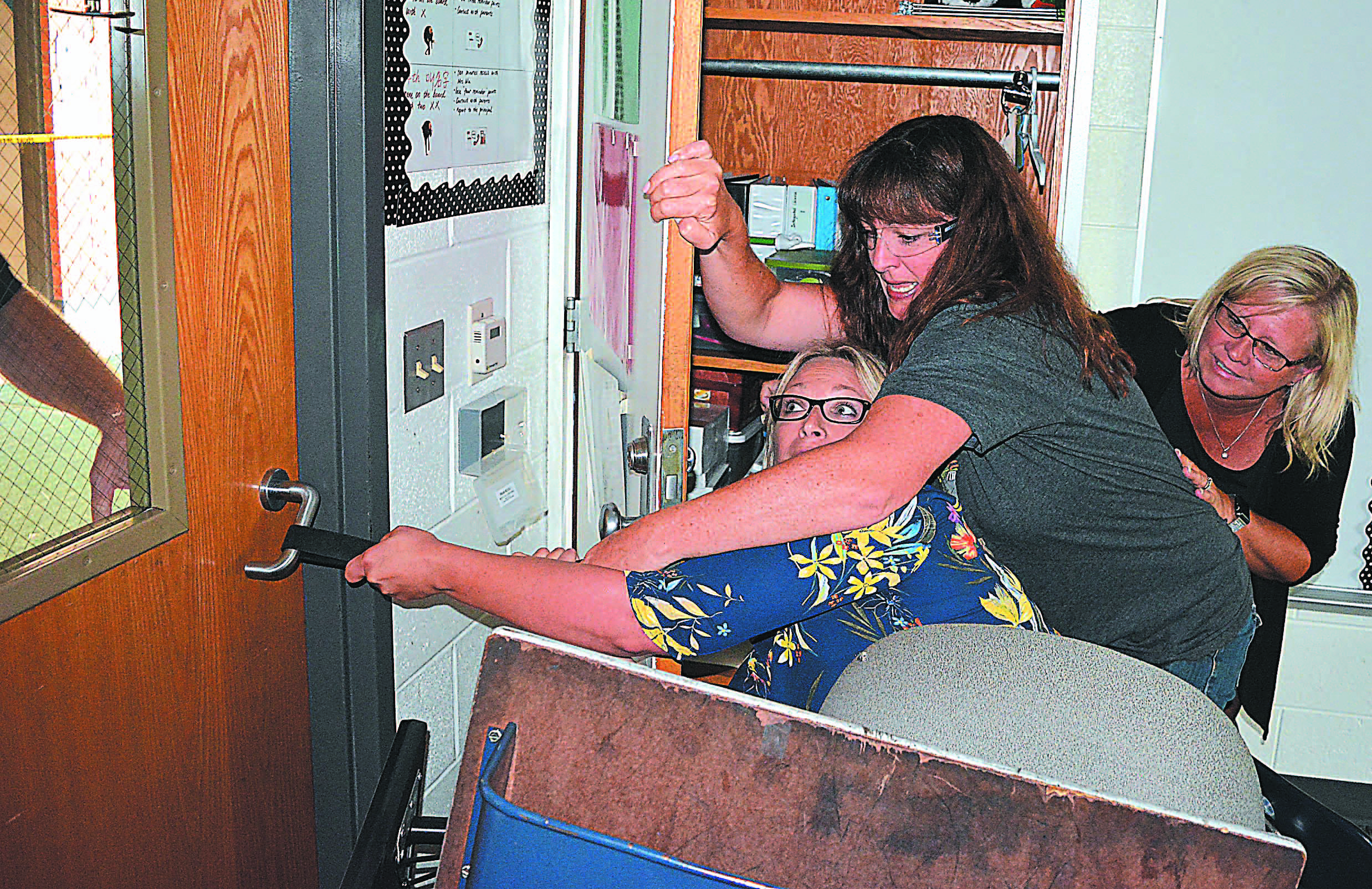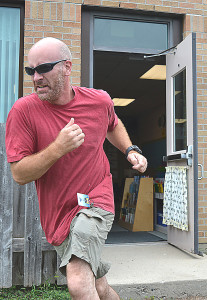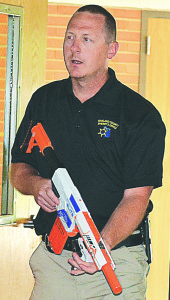
Hope for the best, but prepare for the worst.
Oxford Schools is taking that old maxim to heart as teachers and staff at all five of the district’s elementary schools underwent active shooter response training on Aug. 17 and Aug. 21.
“This is not paranoia. This is not a reaction to something that is a widespread problem,” said Oakland County Sheriff’s Deputy Jason Louwaert, school liaison officer. “It’s just recognizing the fact that bad things could happen and this is what we do when that occurs.”
Louwaert led school employees through some live scenario training as part of the program devised by the ALICE Training Institute, a company based in Medina, Ohio.
ALICE is an acronym that stands for Alert, Lockdown, Inform, Counter and Evacuate.
According to the ALICE Training Institute website, www.alicetraining.com, the program is designed to “empower” people by giving them “the skills and knowledge” they need to respond to active shooter situations and survive by making “their own lifesaving decisions.”
ALICE options are meant to be “proactive,” as opposed to “passive, mandated, one-size-fits-all” approaches, so people can “help themselves until public safety arrives.”
“Traditionally, people have just been taught (to) lock down – something bad happens, hide, get under the table . . . and everything will be okay,” said Louwaert as he addressed teachers and staff at Oxford Elementary School (OES) Friday morning. “That turns out to not be true. It’s one solution for problems that are different every single time.”
“I hate to say it, but in many (of the) instances that we’ve seen from these tragedies, specifically in the U.S., you are more than likely a sitting duck (when the only plan is to lock down and hide),” said Sam Barna, assistant superintendent of business and operations. “I’m not saying that’s always the case, but in many of those instances, simply locking down is not always the best approach. It just depends on the scenario.”
Louwaert explained the basis for the ALICE Training Institute’s program is “there are more options.”

“We’re giving you guys a lot more options now and we’re trying to not be as rigid,” the deputy explained. “We don’t want to create a (standard response policy that states) ‘somebody’s in the building with a gun, this is what we do, no matter what, every single time.’ That doesn’t work because every time is different. This whole program is about giving you guys the options.”
Louwaert noted ALICE training is not telling teachers to stop locking down their classrooms.
“We’re saying if you think that’s what’s best for what’s happening right now, do that. But here are some other options as well,” he said.
“Anything is better than nothing. Do something. Take an active approach to this,” Louwaert stressed. “You shouldn’t be hiding in the corner and hoping everything is going to be okay.”
The main thing ALICE training is designed to do is give people the mental tools they need to survive until law enforcement personnel arrive on scene. “It’s all about buying time, giving us a couple minutes to get here and do what we do,” Louwaert said.
He noted an active shooter “can hurt a lot of people in a very short period of time,” especially if the person holding the gun is not particular “about who they hit.”
Once alerted to an active shooter event, law enforcement personnel will race to the scene.
“If there is a true school shooting here, you’re going to have every on-duty officer in Oakland County and Lapeer County converging on this area,” said OES Principal Jeff Brown.
“Literally, hundreds (of officers),” Louwaert added.
But they can’t get there instantaneously. That’s why the people inside the school have to act and do whatever’s necessary to stay alive.

“As quickly as we want to get here, you guys are going to have to buy us a little bit of time,” Louwaert said. “We will take care of business. We will do what it takes to end the threat when we get here, but we need a couple minutes from you guys and that’s what we’re asking you to do with some of the skills we’re going to show you today.”
Louwaert walked school employees through the different parts of ALICE training.
With regard to the lockdown portion, he explained this means going “beyond locking your door.”
Teachers and staff are encouraged to be “creative” and use whatever is in the room to barricade the door. This can include doing everything from piling furniture in front of the door to using belts, computer cords and tie-down straps to prevent the intruder from being able to open it.
“Keep piling stuff (in front of the door),” Louwaert said. “The more (things) somebody has to climb through (to get to you), the better.”
“All that stuff (in classrooms) is fair game. If we’ve got to replace a computer cord, we’ll be okay,” Brown said.
“You’re not going to get in trouble for saving your life or the students’ lives by using some equipment in the classroom,” Barna said.
Last year, Oxford Schools purchased and installed 543 Nightlock security devices throughout the entire district. These devices allow teachers and staff to quickly barricade doors in the event of an emergency.
“Putting that Nightlock (device) on the door and getting out of the way of that (door) window is a tremendously powerful option,” Brown said.
Because the district has these devices, Louwaert believes locking down a room is “actually not a bad way to go.”
In his opinion, Nightlock is “a good product” that works “pretty well.
“They put us in a lot better shape than just turning the lock on the doorknob and hoping everything’s going to be okay,” he said.
That being said, Louwaert stressed, like anything else in life, these devices are not 100 percent effective.
“There’s no such thing,” he said.
Barna echoed that sentiment.
“Nothing is foolproof,” he said. “If someone wants to get in the building, they’re going to get in the building, regardless of what we have from an equipment standpoint.”
The same holds true for classrooms. Barna said if somebody is determined to get into a room, “they’re going to find a way” to do it. That’s why ALICE gives teachers and staff ideas and ways to slow the attacker down and hinder his or her progress.
“That’s really the key –buying more time,” Barna said.
Louwaert then covered the “counter” part of ALICE training.
Counter does not mean fighting with the intruder via hand-to-hand combat or martial arts, the deputy explained.
Counter involves doing whatever can be done to “distract” an attacker and interfere with his or her ability to shoot or shoot accurately. This can involve throwing whatever is handy at the attacker be it staplers, books, pencils, coffee mugs, anything with sharp edges, etc.
“Shooting is a very complicated process” that requires many “fundamentals” be properly executed to hit a target, Louwaert explained, and “just having something thrown at you will distract that process.”
“If you’re looking at something that’s being thrown at you, you can’t not look at it and while you’re looking at (that object), you can’t shoot,” he said.

“Am I recommending bringing a stapler to a gun fight? No. That’s stupid,” Louwaert added. “But if all you’ve got is a stapler, use it. It’s better than nothing. It’s better than sitting in the corner, waiting to get shot.”
Teachers and staff practiced countering an attacker by throwing soft balls meant to simulate classroom objects at Louwaert as he attempted to shoot them with foam darts fired from a Nerf gun.
In addition to throwing objects, teachers and staff were also taught they can grab an attacker’s arms, hold on to them and use their “dead weight” to stop or slow his or her progress. This can be especially effective if multiple people swarm an attacker and wrap themselves around him or her.
“If you get enough guys and just hang on him, you’ll overpower that guy,” Louwaert said. “He can’t drag around that much dead weight, no matter how big and strong he is.”
Louwaert stressed whatever can be done to distract attackers and “interrupt” their shooting will help the situation.
“That’s going to equal one less round he gets off or if he gets it off, it’s one less round that he gets off accurately,” the deputy said.
When facing an attacker, Louwaert told everyone “it’s okay to fight for your life” and “it’s okay to be violent and protect your students.”
“If it comes to this, do what it takes,” he said.
Following counter options, the teachers and staff learned about the final component of ALICE – evacuation.
Just as it was with the counter training, they were encouraged to be creative and exit the room or building wherever and however they can, be it through a door or window.
“If your windows don’t open, smash them out,” said Louwaert, who added busting through cinder-block walls and drywall to escape are also viable options.
If it’s possible to do, evacuation is a highly favorable option because, as the deputy put it, “the best way to win a gun fight is don’t have it.”
“If somebody is shooting up the other end of this school, there’s no need for me to be here anymore,” he said. “There’s certainly no need for my kids to be here anymore.”
Louwaert reminded teachers and staff that everyone has the ability to make decisions and take actions that can save lives.
“Nobody’s asking you to put on a Superman cape and nobody’s asking you to storm the beachhead or anything like that . . . All it takes is one simple decision to do something and you’re all capable of it,” he said.
Teachers and staff at the high school and middle school will begin doing the ALICE live scenario training in September.
ALICE training will be an annual practice districtwide from now on. “This is not something that we’re just doing as a one-time (thing),” Barna said. “We’re going to be making this part of our procedures . . . We want to become an ALICE-certified district.”
Earlier this year, all district employees were required to complete a 45-minute, online ALICE training course.
According to Barna, the district is looking into doing some form of ALICE training with students, but officials must first determine whether or not it’s going to be mandatory, how to make it “age appropriate” for all the various grade levels and how best to communicate this with parents.
“We’re not there yet. We’ve got to make that decision fairly quickly because I agree it needs to be taught to the children. I really feel that way,” he told the group at OES.

Thank you, Oxford Community Schools, for taking this seriously. Thank you to the staff members for participating in these simulations.